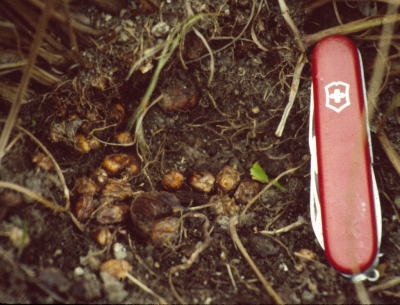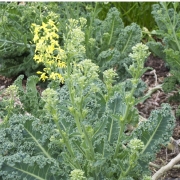SEAKALE, CHUFA, OCA
I’m often questioned, “So what are you growing that’s particularly interesting this year.” It’s a tough question to answer because following the growth of even common plants is interesting year after year, watching how they respond to the vagaries of each year’s weather and pests, changing growing techniques, and other influences. Still, a few plants always elicit a, “You’re growing what?”
Such as, for instance, three edibles: seakale, chufa, and oca. Let’s start with the seakale (Crambe maritima). This plant had been growing at the edge of one of my flower beds for many years but died last year. I never did try eating the plant but had earned a permanent place in the flower bed for its gray-green leaves and attractive sprays of 4-petalled white flowers. Those two characteristics would also rightly land the plant in the cabbage family.
Like cabbage, seakale is edible; unlike cabbage, it needs special treatment before being rendered so. That special treatment is blanching, or shielding the emerging leaves from light to make them more tender and mild-tasting. My plant always seemed too weak to endure such treatment so the plant has been enjoyed only for its good looks. This year, though, I have raised a few seedlings, two of which I planted in the rich soil of the vegetable garden and should be strong enough for a couple of weeks of blanching early next season.
Seakale shoots are too tender for transport so you’ll probably never see them for sale. They were popular in gardens of 200 years ago, though — Thomas Jefferson’s, for one. If flavor turns out to be the reason the plant fell out of favor, I’ll just continue to grow it amongst the flowers.
—————————————————–
Chufa (Cyperus esculentus) is another edible making a return engagement to my garden. This one makes knowledgeable gardener’s raise their eyebrows because it’s very closely related to a pernicious weed, yellow nutsedge. They’re both the same genus and species. I received tubers from J. L. Hudson, Seedsman (http://www.jlhudsonseeds.net/) who claims that the particular selection that they offer does not become weedy; I confirm that claim.
Chufa’s edible portion are the below ground, almond-sized tubers that have a texture an flavor reminiscent of coconut. So you can grow your own “coconut” even where winter temperatures plunge below zero degrees Fahrenheit. Above ground, chufa (and yellow nutsedge) have a grassy appearance except that rolling one of the clumping leaves between your thumb and index finger reveals the triangular cross-section characteristic of sedges. Grass blades are flat.
The main problem in growing chufa is separating the harvested tubers from the soil. Gravel or small stones are about the same size, and a lot harder on your teeth should you accidentally bite into one in a batch of chufa. My plan is to hose down each harvested clump well and then to stir the tubers in water just enough to let anything with the density of stone settle out first. And chew carefully.
—————————————————-
Oca (Oxalis tuberosa) is perhaps the most interesting new plant in my garden, among edibles, at least. It’s related to one of my worst garden weeds, creeping wood-sorrel (O. corniculata). It’s a staple food of the Andean highlands and an iffy crop, around here at least.
The limitations to growing oca are that it needs a long season and it forms tubers only when days grow short (at which time cold weather is likely to kill stems and leaves). On the other hand, the plant has been cultivated for centuries so there are many varieties. New Zealanders have been enjoying and growing oca (which there are called yams) for about 150 years and their varieties are more likely suited here.
I don’t know the provenance of the oca tuber I planted so it could just take up garden space the whole season then die back leaving nothing of value underground. My plan is to keep it warm in autumn beneath a cover of clear plastic, which would be needed even for the most adapted varieties.
And then there’s the flavor. Many varieties, many flavors, from tart to sweet. Oca is used like potatoes and also eaten raw. In the Andes, super-tart varieties are freeze-dried by being left outside on the ground on hot, sunny days and cold, freezing nights. Stamping on defrosting tubers speeds water removal. Interesting, yes?
—————————————————–
Seakale, chufa, and oca are among perennial vegetables that, once planted, come back year after year of their own accord. Others include black salsify, groundnut, Jerusalem artichoke, ramps, skirret, Welsh onion, and, of course, asparagus. For more about perennial vegetables, see Perennial Vegetables: From Artichokes to Zuiki Taro, A Gardener’s Guide to Over 100 Delicious and Easy to Grow Edibles by Eric Toensmeier.
—————————————————–








Sea Kale can be eaten without blanching: The Broccolis in spring and the leaves in fall.
http://www.permaculturenursery.com/perennialbroccolis.pdf